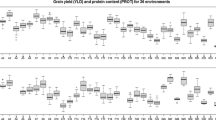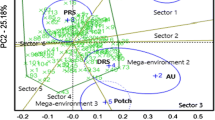Abstract
Different production environments are being adopted by farmers. Therefore, allocation of resources to breeding research that targets different production environments should be continuously assessed. Agronomists should conduct extensive hybrid × production environment interaction research before recommending breeders to conduct separate breeding programs for each production environment. The lack of interactions between genotypes and production environments (e.g., tillage) would not justify conducting separate breeding programs and duplicating breeding resources. On the other hand, separate breeding programs would be necessary if cultivar rankings differ. The purpose of this paper is to review the available literature on experiments designed to test genotype × tillage interactions (GT) in maize (Zea mays L.). No-till system (NT) and conventional till system (CT) were utilized as examples of different production environments. The majority of experiments reviewed showed that there is no need to develop cultivars specific to NT because the cultivars that were developed under CT systems performed relatively the same under NT. The magnitude of GT interactions found was very small to expect better cultivars from breeding under NT. Additional research is needed to confirm these conclusions, especially when applied to other production environments (e.g., development of cultivars under organic conditions). Scientists should evaluate genotype by tillage interactions before investing additional resources in breeding for those specific target environments. Top yielding genotypes seem be consistent across years, locations, inputs; and most of the present evidence suggests that breeding for specific till systems is not necessary.
Similar content being viewed by others
References
Agele SO, Ewulo BS, Oyewusi IK (2005) Effects of some soil management systems on soil physical properties, microbial biomass and nutrient distribution under rainfed maize production in a humid rainforest Alfisol. Nutr Cycl Agroecosyst 72:121–134. doi:10.1007/s10705-004-7306-x
Al-Kaisi MM, Yin X (2005) Tillage and crop residue effects on soil carbon and carbon dioxide emission in maize-soybean rotations. J Environ Qual 34:437–445
Al-Kaisi MM, Yin X, Licht MA (2005) Soil carbon and nitrogen changes as affected by tillage system and crop biomass in a maize-soybean rotation. Appl Soil Ecol 30:174–191. doi:10.1016/j.apsoil.2005.02.014
Anderson EL (1986) No-till effects on yield and plant density of maize hybrids. Agron J 78:323–326
Bayhan Y, Kayisoglu B, Gonulol E, Yalcin H, Sungur N (2006) Possibilities of direct drilling and reduced tillage in second crop silage maize. Soil Tillage Res 88:1–7. doi:10.1016/j.still.2005.04.012
Bermudez M, Mallarino AP (2004) Maize response to starter fertilizer and tillage across and within fields having no-till management histories. Agron J 96:776–785
Beyaert RP, Schott JW, White PH (2002) Tillage effects on maize production in a coarse-textured soil in southern Ontario. Agron J 94:767–774
Brakke JP, Francis CA, Nelson LA, Gardner CO (1983) Genotype by cropping system interactions in maize grown in a short-season environment. Crop Sci 23:868–870
Burger H, Schloen M, Schmidt W, Geiger HH (2008) Quantitative genetic studies on breeding maize for adaptation to organic farming. Euphytica 163:501–510. doi:10.1007/s10681-008-9723-4
Burgess MS, Mehuys GR, Madramootoo CA (1996) Tilage and crop residue effects on maize production in Quebec. Agron J 88:792–797
Busscher WJ, Sojka RE (1987) Enhancement of subsoiling effect on soil strength by conservation tillage. Trans ASAE 30:888–892
Busscher WJ, Sojka RE, Doty CW (1986) Residual effects of tillage on Coastal plain soil strength. Soil Sci 141:144–148. doi:10.1097/00010694-198602000-00007
Carter PR, Barnett KH (1987) Corn-hybrid performance under conventional and no-tillage systems after thinning. Agron J 79:919–926
Carter MR, Sanderson JB, Ivany JA, White RP (2002) Influence of rotation and tillage on forage maize productivity, weed species, and soil quality of a fine sandy loam in the cool-humid climate of Atlantic Canada. Soil Tillage Res 67:85–98. doi:10.1016/S0167-1987(02)00043-0
Chassot A, Stamp P, Richner W (2001) Root distribution and morphology of maize seedlings as affected by tillage and fertilizer placement. Plant Soil 231:123–135. doi:10.1023/A:1010335229111
CTIC (1983) 1982 Survey of conservation tillage practices. Conservation Technology Information Center, West Lafayette, IN
CTIC (2005) 2004 National crop residue management survey. Conservation Technology Information Center, West Lafayette, IN
Dam RF, Mehdi BB, Burgess MSE, Madramootoo CA, Mehuys GR, Callum IR (2005) Soil bulk density and crop yield under eleven consecutive years of maize with different tillage and residue practices in a sandy loam soil in central Canada. Soil Tillage Res 84:41–53. doi:10.1016/j.still.2004.08.006
Doran JW (1980) Soil microbial and biochemical changes associated with reduced tillage. Soil Sci Soc Am J 44:765–771
Duiker SW, Haldeman JF Jr, Johnson DH (2006) Tillage × maize hybrid interactions. Agron J 98:436–442. doi:10.2134/agronj2005.0063
Fabrizzi KP, Garcia FO, Costa JL, Picone LI (2005) Soil water dynamics, physical properties and maize and wheat responses to minimum and no-tillage systems in the southern Pampas of Argentina. Soil Tillage Res 81:57–69. doi:10.1016/j.still.2004.05.001
Filipovic D, Košutic S, Gospodaric Z (2004) Influence of different soil tillage systems on fuel consumption, labour requirement and yield in maize and winter wheat production. Agric Sci Prof Rev 10:17–23
Franzluebbers AJ, Stuedemann JA (2008) Early response of soil organic fractions to tillage and integrated crop-livestock production. Soil Sci Soc Am J 72:613–625. doi:10.2136/sssaj2007.0121
Franzluebbers AJ, Hons FM, Zuberer DA (1995) Tillage and crop effects on seasonal dynamics of soil CO2 evolution, water content, temperature, and bulk density. Appl Soil Ecol 2:95–109. doi:10.1016/0929-1393(94)00044-8
Funnermark WL, Hallauer AR (1985) Cold tolerance in corn hybrids as affected by tillage systems and planting dates. Proc Iowa Acad Sci 92:58–62
Govaerts B, Mezzalama M, Sayre K-D, Crossa J, Nicol J-M, Deckers J (2006) Long-term consequences of tillage, residue management, and crop rotation on maize/wheat root rot and nematode populations in subtropical highlands. Appl Soil Ecol 32:305–315. doi:10.1016/j.apsoil.2005.07.010
Griffith DR, Kladivko EJ, Mannering JV, West TD, Parsons SD (1998) Long-term tillage and rotation effects on maize growth and yield on high and low organic matter, poorly drained soils. Agron J 80:599–605
Hallauer AR, Colvin TS (1985) Corn hybrids response to four methods of tillage. Agron J 77:547–550
Halvorson A-D, Mosier A-R, Reule C-A, Bausch W-C (2006) Nitrogen and tillage effects on irrigated continuous maize yields. Agron J 98:63–71. doi:10.2134/agronj2005.0174
Hayhoe HN, Dwyer LM, Stewart DW, White RP, Culley JLB (1996) Tillage, hybrid and thermal factors in maize establishment in cool soils. Soil Tillage Res 40:39–54. doi:10.1016/S0167-1987(96)01045-8
Hersterman OB, Pierce FJ, Rossman EC (1988) Performance of commercial corn hybrids under conventional and no-tillage systems. J Prod Agric 1:202–206
Holanda FSR, Mengel DB, Paula MB, Carvaho JG, Bertoni JC (1998) Influence of crop rotations and tillage systems on phosphorus and potassium stratification and root distribution in the soil profile. Commun Soil Sci Plant Anal 29:2383–2394. doi:10.1080/00103629809370118
Hooker B-A, Morris T-F, Peters R, Cardon Z-G (2005) Long-term effects of tillage and maize stalk return on soil carbon dynamics. Soil Sci Soc Am J 69:188–196
Iowa State University (2005) Resources conservation practices: tillage management and soil organic matter [Online]. Iowa State University Extension Service, Ames. Available at: http://www.extension.iastate.edu/Publications/PM1901I.pdf (Accessed Feb 2007)
Jug D, Stipesevic B, Jug I, Samota D, Vukadinovic V (2007) Influence of different soil tillage systems on yield of maize. Cereal Res Commun 35:557–560. doi:10.1556/CRC.35.2007.2.98
Karlen DL, Sojka RE (1985) Hybrid and irrigation effects on conservation tillage corn in The Coastal Plain. Agron J 77:561–567
Kaspar TC, Crosbie TM, Cruse RM, Erbach DC, Timmons DR, Potter KN (1987) Growth and productivity of four corn hybrids as affected by tillage. Agron J 79:477–481
Khajanji S-N, Gautam R-C, Patel J-R (2002) Effect of tillage and weed control methods on growth and yield of maize. J Maharashtra Agric Univ 27:277–279
Košutic S, Filipovic D, Gospodaric Z (1998) Influence of different soil tillage systems on yield, energy and labour requirement in spring barley production. Poljoprivreda 4:67–75
Kuhlman DE, Steffey KL (1982) Insect control in no-till corn. Proc Annu Corn Sorghum Res Conf 37:118–147
Laszlo P, Gyuricza C (2004) Effect of the ridge tillage system on some selected soil physical properties in a maize monoculture. Acta Agron Hung 52:211–220. doi:10.1556/AAgr.52.2004.3.1
Lessiter F (1983) 1982–1983 No till farmer acreage survey. No-till Farmer, Brookfield, WI, pp 8–9
Lorenzana RE, Bernardo R (2007) Genetic correlation between corn performance in organic and conventional production systems. North Central Regional Corn Breeding Research Meeting, St. Charles, pp 21–22. http://corn2.agron.iastate.edu/NCR167/Abstracts/2007/NCCC167%20abstract%20Lorenzana.pdf. Cited 02 February 2009
Monneveux P, Quillerou E, Sanchez C, Lopez-Cesati J (2006) Effect of zero tillage and residues conservation on continuous maize cropping in a subtropical environment (Mexico). Plant Soil 279:95–105. doi:10.1007/s11104-005-0436-3
Newhouse KE, Crosbie TM (1986) Interactions of maize hybrids with tillage systems. Agron J 78:951–954
Newhouse KE, Crosbie TM (1987) Genotype by tillage interactions of S1 lines from two maize synthetics. Crop Sci 27:440–445
Nyvall RF (1982) Disease control. In: Cruse RM, Horton R (eds) Tillage and the soil environment. Iowa Cooperative Extension Service Bull. CE-1755
Pereira de Mello Ivo WM, Mielniczuk J (1999) Influence of soil structure on the distribution and morphology of maize roots under three tillage methods. Rev Bras Cienc Do Solo 23:135–143
Qin R, Stamp P, Richner W (2006) Impact of tillage on maize rooting in a Cambisol and Luvisol in Switzerland. Soil Tillage Res 85:50–61. doi:10.1016/j.still.2004.12.003
Ratonyi T, Huzsvai L, Nagy J, Megyes A (2005) Evaluation of soil tillage systems in maize production. Acta Agron Hung 53:53–57. doi:10.1556/AAgr.53.2005.1.7
Sullivan P (2004) Sustainable soil management: soil systems guide. ATTRA National Sustainable Agriculture Information Service. National Center for Appropriate Technology (NCAT)
Tripplet GB Jr (1985) Principles of weed control for reduced-tillage corn production. In: Wiese AF (ed) Weed control in limited-tillage systems. Weed Science Society of America, Champaign, IL
Vlachostergios DN, Roupakias DG (2008) Response to conventional and organic environment of thirty-six lentil (Lens culinaris Medik.) varieties. Euphytica 163:449–457. doi:10.1007/s10681-008-9712-7
Wall DA, Stobbe EH (1983) The response of eight corn (Zea mays L.) hybrids to zero tillage in Manitoba. Can J Plant Sci 63:753–757
Yalcin H, Cakir E (2006) Tillage effects and energy efficiencies of subsoiling and direct seeding in light soil on yield of second crop maize for silage in Western Turkey. Soil Tillage Res 90:250–255. doi:10.1016/j.still.2005.10.003
Youngquist WC (1983) Maize breeding for the Nebraska panhandle influence of tillage system and location on genotype testing and selection. MS Thesis. University of Nebraska
Zougmore R, Nagumo F, Hosikawa A (2006) Nutrient uptakes and maize productivity as affected by tillage system and cover crops in a subtropical climate at Ishigaki, Okinawa, Japan. Soil Sci Plant Nutr 52:509–518. doi:10.1111/j.1747-0765.2006.00067.x
Author information
Authors and Affiliations
Corresponding author
Rights and permissions
About this article
Cite this article
Carena, M.J., Yang, J., Caffarel, J.C. et al. Do different production environments justify separate maize breeding programs?. Euphytica 169, 141–150 (2009). https://doi.org/10.1007/s10681-009-9908-5
Received:
Accepted:
Published:
Issue Date:
DOI: https://doi.org/10.1007/s10681-009-9908-5




